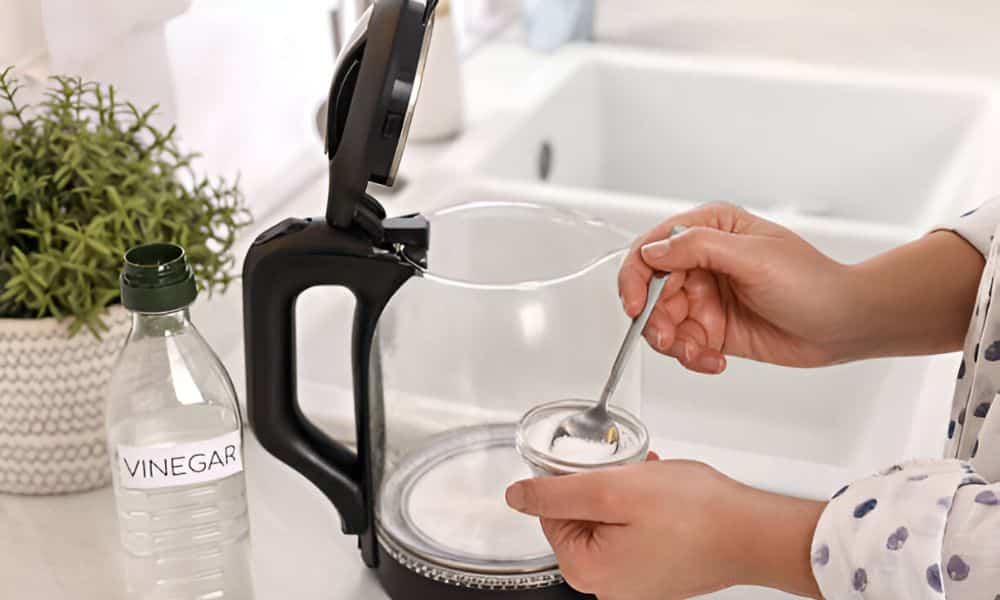Last month, I brewed my morning tea, and something felt wrong. The taste was dull. The smell was off. I poured it out and tried again. No change. I looked inside the kettle. A white crust hugged the bottom. That was the culprit. Not my tea leaves. Not the water. Over time, minerals from water collect and stick. They form hard layers. These layers ruin both the taste and the kettle. I had no idea how fast it could happen. That’s how I learned how to descale electric tea kettle at home. No tools. Just a few things from my kitchen. It changed my daily routine. A clean pot boils faster. It lasts longer. And most importantly, it makes tea taste fresh again. Descaling is simple, and I’ll show you how.
Signs Your Electric Kettle Needs Descaling
One morning, I made tea like always. The water looked cloudy. It didn’t smell right. I saw white flakes floating inside the kettle. That’s when I knew something was wrong.
White spots and cloudy water mean limescale has started to build up. This comes from minerals in the water. These minerals stick to the inside and get worse over time. That build-up can slow everything down.
Next came the taste. My tea turned sharp and metallic. It had lost that warm, full flavor. I thought it was the tea itself—but it wasn’t. The problem was the kettle.
Bad taste in your tea or coffee is a clear sign needs cleaning. Even a thin layer of scale can change the taste. It makes every drink feel off.
I also noticed it took longer to boil. What once took two minutes now takes five. I’d stand there, waiting, wondering why.
Slow boiling means the heating part is working harder through thick scales. That can lead to higher energy use.
How to Descale Electric Tea Kettle: Step-by-Step
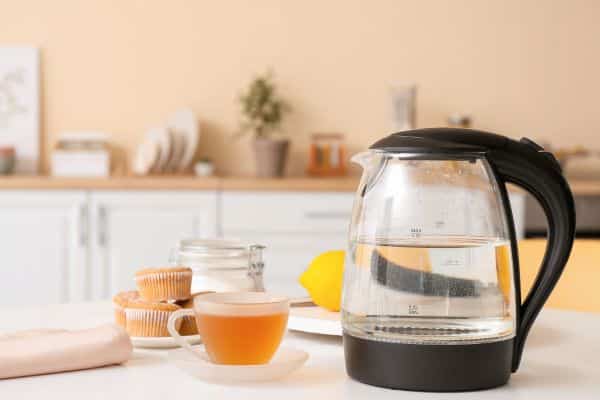
This is the method I’ve used for years. It’s easy. It works. And it only takes a few minutes.
You’ll need a few simple items:
- White vinegar or lemon juice
- Water
- A soft cloth
- A clean sink
Step 1:
Pour equal parts vinegar and water into the kettle. Fill it halfway or just above the scale line. A 1:1 ratio breaks down most mineral build-up in one go.
Step 2:
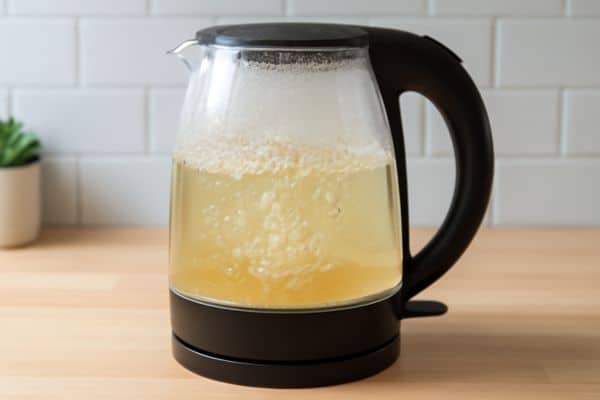
Boil the mixture completely. Let the kettle switch off on its own. Boiling activates the acid and softens the scale fast.
Step 3:
Leave the hot liquid inside for 15 to 20 minutes. Don’t rush this part. Soaking time gives the solution space to do the heavy lifting.
Step 4:
Pour everything out. You’ll likely see flakes or white streaks. That’s the limescale breaking loose. loose. This is proof the solution worked—visible results you can trust.
Step 5:
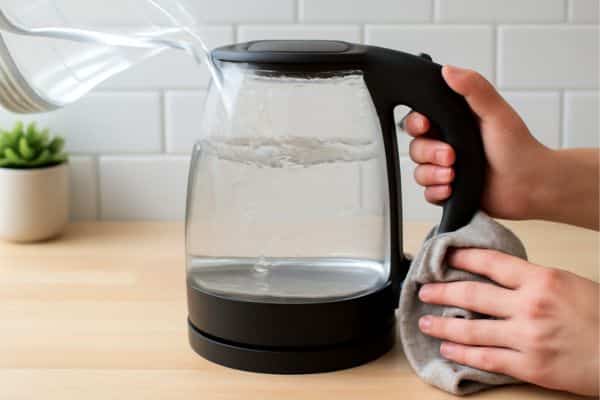
Rinse the kettle with clean water. Wipe it gently with a soft cloth. A second boil with plain water clears any leftover smell or taste. This simple step ensures that your best non-toxic electric tea kettle stays fresh and odour-free for a healthier experience.
Other Natural Ways to Clean Your Kettle
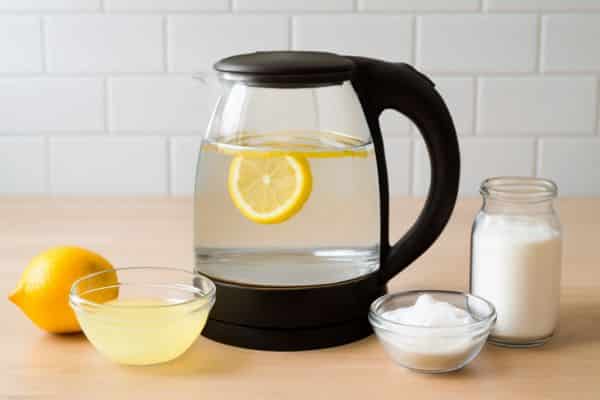
Vinegar works great. But it’s not the only option. I’ve tested a few others too—some for the smell, some just out of curiosity.
Lemon Juice
This one is my favourite. It smells fresh and doesn’t feel harsh. I squeeze two lemons and add water to fill the kettle halfway. Then I boil it, just like the vinegar method. Lemon juice is gentle but powerful. It works well for light build-up and adds a clean citrus scent.
Baking Soda
This method takes a bit more work. I mix a spoonful of baking soda with water, boil it, and scrub gently with a cloth. It’s not strong like vinegar, but it lifts off stains and smells. Use baking soda for light cleaning or as a follow-up rinse after descaling.
Citric Acid
This one surprised me. I used one tablespoon of citric acid with water. Boiled it. Let it sit. The result? A spotless kettle. No flakes. No smell. Citric acid is great for deep scale, especially if vinegar hasn’t worked well.
Vinegar vs. Others
Vinegar is strong, cheap, and fast. But the smell isn’t for everyone. Lemon juice is mild and smells better. Citric acid hits harder but costs more. Baking soda is gentle, best for daily use. Choose vinegar for deep cleaning, lemon for a fresh scent, citric acid for tough scale, and baking soda for regular care.
How Often Should You Clean Your Electric Kettle?
This depends on how much you use it. I boil water every day, sometimes twice. So my kettle builds up scale fast.
Daily use with hard water means more cleaning. I descale mine every two weeks. It keeps the inside clean and the tea tasting sharp.
If you use it less, once a month works fine. That’s enough to stop flakes and slow build-up.
Soft water? You’re lucky. It leaves less residue. But it still adds up over time. So keep an eye on the inside. A quick look can tell you what it needs.
I set a reminder on my calendar. Just a small note—“kettle clean day.” It keeps me on track. Simple habit. Big payoff.
Staying on schedule saves time. It also makes deep cleaning easier. Your lasts longer. And your tea always tastes just right.
Tips to Keep Your Kettle Clean Longer
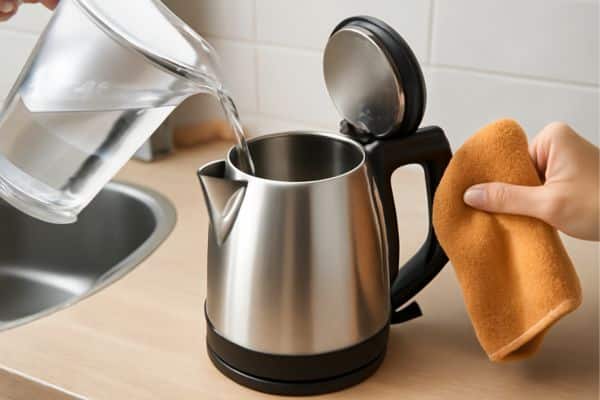
I’ve learned a few small tricks that make a big difference. These habits keep my kettle fresh and save me time on cleaning.
Empty the kettle after every use. Don’t let water sit. It leaves mineral traces, even in just a few hours. Leaving water behind speeds up scale and stains.
Use filtered water. It has fewer minerals, which means less limescale and a cleaner boil.Filtered water also slows down the build-up and makes tea taste better.
Wipe the inside and outside dry. I keep a soft cloth nearby. A quick wipe stops spots and streaks.Dry stay cleaner and look newer.
Never leave water overnight. It makes the kettle smell musty. It also gives minerals more time to settle. Fresh water, every time. That’s the secret.
Final Thoughts
Cleaning your kettle is simple. It doesn’t take much time. A few easy steps, and you’re done.
A clean kettle boils faster. It lasts longer. Most of all, it makes your tea or coffee taste better. Every cup feels fresh again.
Start small. Try the vinegar method or lemon juice. Use what you have at home. Build the habit once, and it gets easier each time.
Now that you know how to descale an electric tea kettle, go ahead—give yours the care it deserves.

